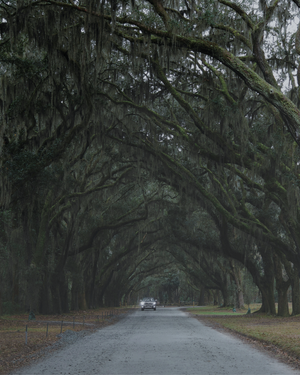by Laura Holt
“In the olden times, way back in the day, there were always witches going around, and they could get out of their skin whenever they wanted. So, you had to be real careful when building your house, because if you had any crack in the wood, they could ease inside and ride you at night, stealing your energy so that you would walk around during the day feeling like you had a bad case of the flu. Night hags, we called them.” ~ Skin! Wey You No Know Me? Joel Chandler Harris, 1883
Witches have always been my favorite supernatural entity, ever since I first read Roald Dahl’s The Witches in seventh grade and fell head over heels with the concept of a female with the power to determine her own fate. It’s true that when we think of witchcraft trials, our minds go immediately to Salem. Yet the south has its own witchy legend, one my grandaddy was fond of telling: the boo hag.
The boo hag, also known as the night hag, night mare, or hag, is a winged witch, most often a woman, with the ability to shed her skin, take to the air via a pair of bat-like wings, and visit the homes of sleeping victims at night. There, she sits on a person’s chest and drains their lifeforce then returns home and re-dons her skin before the sun comes up. This is where the term “being ridden by the hag” comes from.
As an overly-imaginative child who lived and breathed The Wizard of Oz, the boo hag seemed to have a lot in common with the Wicked Witch of the West, with her different colored skin and flying abilities. This made her a fascinating character, and a frightening one. Many nights, I went home both afraid and hopeful that a boo hag would sneak through the crack of my bedroom window. Even now, an adult in my thirties, I can’t help but wonder if boo hags really exist, and if they are, how to find one. Before I could do that, however, I needed to make sure I was protected.
The boo hag is a woman who defies patriarchal norms. In her true form, she has the ability to bring even the strongest man to his knees. He has no power against her, no way to fight back, which must make her a monster. Instead, he has to seek out the aid of the church in order to combat her, thus emphasizing her demonic nature. And the weapon that he often arms himself with is familiar to those of us who have watched black and white horror films: salt.
Salt, in many cultures, is seen as a purification agent, a natural talisman against black magic. “Form a circle of salt to protect from zombies, witches, and old boyfriends,” Allison tells Max in the 1993 pop culture movie Hocus Pocus. While Pliny the elder tells us in his Naturalis Historia if a person takes “two dried walnuts, two figs, and twenty leaves of rue with a grain of salt while fasting, he will be proof against all poisons.” Even in ancient Rome, salt was used as an antiseptic, and the Roman word for salt, sal, is ascribed to Salus, goddess of health.
Armed with this knowledge, and a jar of salt, it was time to go straight to the source of the boo hag myth. And there is no other city in Georgia more likely to be home to this witchy woman than Savannah.
Savannah is the oldest city in Georgia, founded in 1733 by General James Oglethorpe as the original state capital. Although Atlanta has since taken that title, Savannah retains its place as crown jewel of the state with little to seemingly no effort. Driving down the cobblestoned streets of the historic district beneath thick, moss-covered oaks, I noted the houses as I passed. Each one sported a distinct bright blue shade on the windows and doors. This paint, commonly referred to as haint paint, was made from the dye of the indigo plant in colonial times. The strong smell and sky-like color was once believed to ward off evil spirits, like the boo hag.
Eager to get a closer look, I paid a visit to The Haint House, aptly named for its all-over indigo blue color. According to Moody Moons, one of my favorite travel bloggers, this house is supposed to be home to all kinds of supernatural entities. It’s even been featured in a Paranormal Investigation, where it was awarded a rating of 4.5 out of 5 on their Fright-O-Meter.
That’s pretty spooktastic.
Unfortunately, I didn’t see any skinless specters while I was there, although I did feel like quite the hag walking around the grounds, and none of my photos or revealed anything out of the ordinary. Still, I wasn’t giving up just yet. Savannah is not only famous for paranormal activity. It also happens to be home to many descendants of the Gullah people who first brought the boo hag’s story to our shores.
Gullah is a creole faith introduced to the US by African Americans enslaved in Georgia, the Carolinas, and Florida that contains a range of supernatural beliefs. I was introduced to it by Patricia Sabree, an artist and practitioner of Gullah who runs a studio in Savannah, GA, featuring paintings and sculptures depicting powerful females of all ages, shapes, and sizes. When asked why women feature in her art, she explained how the feminine form in its true state is powerful. In Gullah, the female body in all stages of life is considered something to be valued, not feared or repressed, and age brings us closer to becoming the powerful, wise woman we’re meant to be.
So why the fear of the boo hag, then? If Gullah culture celebrates powerful females, how did the boo hag become a twisted, hated monster in modern folklore? With this question in mind, I headed to the one place I knew I could find the answers: the library.
The Georgia Historical Society’s library in Savannah is on Whitaker Street in a tall white limestone building, its entrance framed by Greek revival columns. Its archives house one of the oldest collections of manuscripts in the country. Think the Hogwarts’ Library for history buffs. Here, among tall shelves, plush carpet, and golden reading lamps, I found what I was searching for: the truth. That witches were not always portrayed as evil in Gullah lore. Rather, the boo hag is a character born from a much darker history, one that will forever stain southern history, when African enslaved people used hoodoo to protect themselves and their loved ones from abuse, and worse, and were persecuted for it.
Hoodoo, a low country faith practiced by the Gullah people, has long been confused with its sister religion, voodoo. And like any misunderstood magical practice, many who use it have been viewed with suspicion and fear. This was especially true in the 1800s, when disease ran rampant, crops died in harsh conditions, and infant mortality was high. Women, especially those who practiced healing and midwifery or followed a different religious belief, were often blamed for the problems of others. One of the only records I found concerned an elderly African widow who’d been accused of shedding her skin and shapeshifting into a toad so that she could deposit a gris-gris, or charm, bag in her neighbor’s garden to curse him. Because the accuser was also a black man, the marshal threw out the case after only a cursory questioning of the supposed witch, who denied the charges.
Unmarried women had little rights then, and black women would have had even less, a fact which still stuns me. For every right we fight for as women, two more are needed for women of color. Because I’m a white woman, men at least pretend to listen before telling me to sit down and be quiet. If I was black, I wouldn’t even get that. And after learning about this trial, I realized that the story of the boo hag is not a cautionary fable about marrying wisely, nor is it a legend about a real, soul-sucking monster. It is one of many tales that teach us at a young age to behave like “good girls” lest we become ugly and unlovable. That tell us we should be more like the princess and less like the wicked witch because it’s the only way we will ever get our happily ever after. And who among us doesn’t want that in some form or fashion, right?
So, we listen.
We hang up our brooms, take off our horns, and stuff our feet into pointy, uncomfortable shoes that are two sizes too small, then sit and wait for prince charming to show up. However, what we don’t realize, often until it’s too late to stop our impending doom, is it’s not only our physical natures we’re suppressing. It’s our spiritual ones. Our soul songs. Our heart cantador, heart stories. Our wildest self. And the way to get back to is to embrace who we are.
Be the hermit in the forest who gets along better with animals than people. The single mom who lays on the couch on Saturday and does nothing but read and eat chocolates because she needs some time to herself. The working wife who hires a maid because housework isn’t her thing. The night owl who’s most awake when the moon is bright and takes her pleasure in having an abundance of lovers. The cackling hag that keeps her secret treasures in a hidey hole under a loose floorboard.
Love your wrinkles, your crinkles, your laugh-lines and flyaway silvery gray hairs. Love your body, whatever its shape, and dress in clothes that make you feel like you. Treasure your stories, including the bad ones, because they made you who you are. Speak your mind, even if they call you difficult. Trust me, it’s a compliment. And may a little bit of the wild thing, the boo hag, reside inside every one of us.
Want more? Read about Laura's first stop on her feminist journey through Southern Folklore, the legend of Huggin' Molly.

